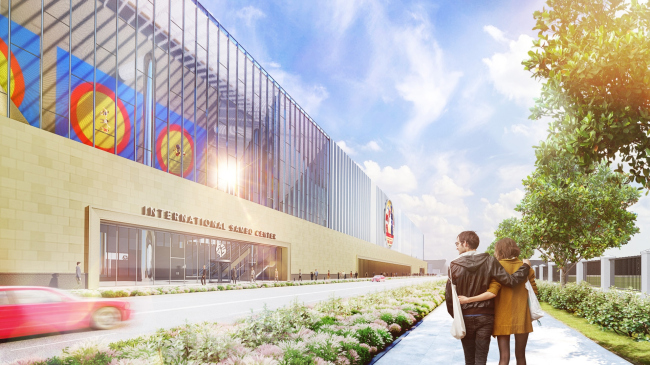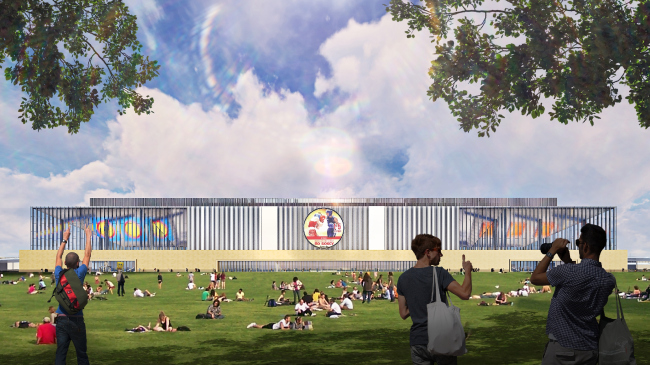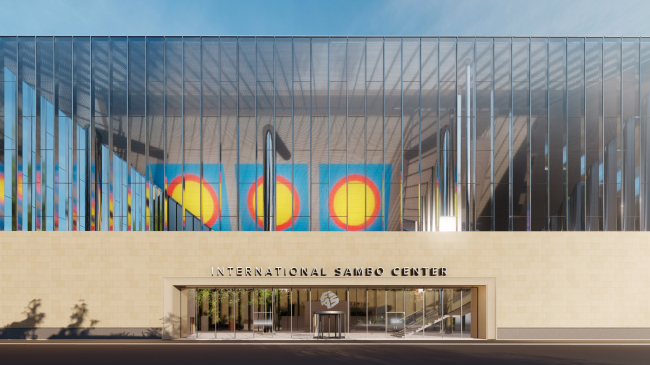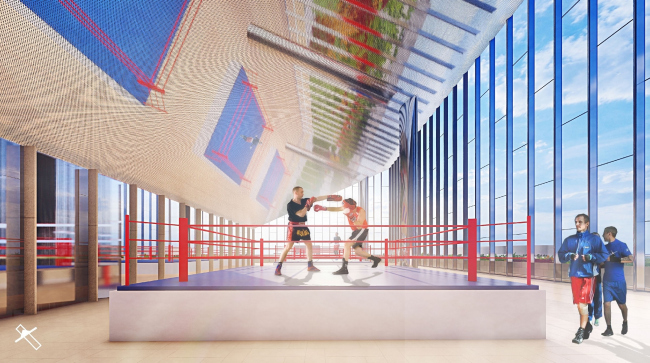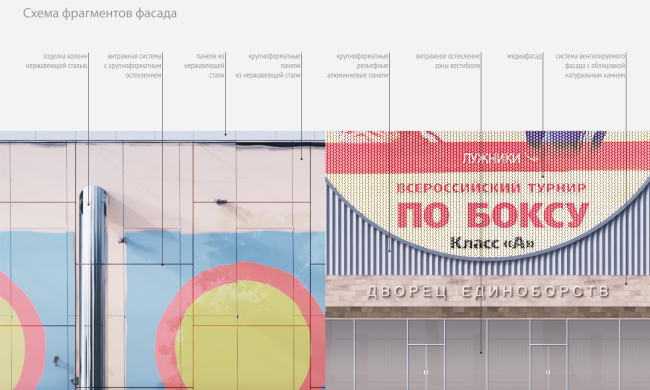|
Published on Archi.ru (https://archi.ru) |
|
| 30.07.2019 | |
|
The Periscope Principle |
|
|
Natalia Koriakovskaia |
|
| Architect: | |
| Yuliy Borisov | |
| Studio: | |
| UNK | |
|
Yuliy Borisov found a nontrivial image that turned a rank-and-file “crate” project of the Palace of Martial Arts in Luzhniki into an iconic building, glittering and modern, yet endowed with contextual allusions and capable of active interaction with people and the surrounding territory. The Palace of Marshal Arts in Luzhniki. View from the Luzhnetsky DriveCopyright: © UNK projectFor the record, let us start by saying that the volumetric solution of the parallelepiped standing on the rectangular land site between the Luzhnetsky Proezd and the Third Transport Ring does not belong to UNK project. The concept by Yuliy Borisov won in the closed-door competition that was initiated by the chief architect of Moscow, Sergey Kuznetsov, in order to revise the volume that looked somewhat “unsportsmanlike”, in spite of the fact that it was meant to host not just one but two sports organizations: the unarmed self-defense federation and the boxing federation. Sergey Kuznetsov, as is widely known in the professional circles, is an ardent advocate of competition procedures: “What we do is create a healthy competitive environment for the architects, which vividly demonstrates the best projects, including to the participants themselves – the chief architect of the nation’s capital stresses – When different teams work on one and the same project, it helps everyone to see alternative points of view; the participants of the contest share their ideas, and the professional community is developing”. The specifications were developed by the Moskomarkhitektury together with TPO “Pride”. Besides UNK project, the competition involved: TPO “Pride”, KAMEN architecture/art group Timur Bashkaev Architectural Bureau, Vladimir Plotkin’s Reserve Union, and ASADOV Bureau. The first two contestants submitted two versions each, which yielded a total of ten concepts, the detailed description of which is available here. The competition was ultimately won by UNK project. As for the parallelepiped shape, it did not appear by chance but became the result of specifics and limitations of the land site. The site is narrow and long, its length being more than 330 meters, the aspect ratio one to five. On the one side it is limited by the Third Transport Ring, and on the other – by the Luzhniki Street, only 35 meters wide, which makes the viewing perspective comparatively close – there will be no chance of looking at this building from a distance. The Third Transport Ring, which in this place is called Novoluzhnetsky Drive, is essentially a wall, a tall flyover with a parking lot underneath it. Making the building tall enough was impossible as well because of the 27-meter height restriction determined by the proximity (even if on one side) of the architectural ensemble of the Novodevichiy Monastery. Digging deep into the ground was also something that the client prohibited to do because of the budget and time constraints. In addition, we will remind you that the rectangular crate-like volume had been in fact designed and approved of; all that the contestants had to do was propose some improvements within the already existing parameters that were, as we can see, rather strictly defined – not to put too fine a point on it, the task boiled down to drawing the façades. However, UNK project, just like their rivals, got down first of all to the functional zoning and revision of the volumes – even if within the framework of the predefined contours. “This task of “cladding the façades” was not exactly achievable – Yuliy Borisov explains – Essentially, what you’ve got here is a warehouse, and no matter what you do to it – various fancy decorations, windows, and such like – it will look like a fake because you will still be getting a “crate” or a monstrous “brick”. This is why the architects decided to proceed from the function itself – they broke it down into segments space-wise, and let it show through on the façades, making this kind of “telltale” architecture. The Palace of Martial Arts in Luzhniki, the competition-winning project 2019Copyright: © UNK projectFunction-wise, this large block consists in fact of not one but two different buildings with independent engineering systems, entrances and infrastructure; the only thing that the unarmed self-defense federation and the boxing federation have in common is a media screen billboard mounted on the main façade. “When we got the original zoning project from our colleagues, the functions were mixed up – for, example, there were two competition halls sharing one foyer, the utility lines were also mixed up, and, at the same time, even slightly incomplete. Then it turned out that these two organizations were not connected in any way whatsoever, and it was unclear how they would share the time in that common foyer. Architecture is essentially a function that’s been put into space – but there was no elaboration for it. If we wanted to envision the zoning, what we had to do was mentally live in this building for a few days together with our clients, which we did. This is a very complex complex because it combines gyms, a mini hotel, the management office, a medical block, swimming pools, cafes, and whatnot. In the long run, we completely divided these functions between the two organizations, including the utility lines – and our customers liked that idea. The only thing that was sort of hard to split in two was the media screen”. The Palace of Martial Arts in Luzhniki. View from the Luzhnetsky DriveCopyright: © UNK projectAs for the sports function, at some places it requires natural light, and at some places it can easily do without. Composition-wise, this gave the architects some room for maneuver: two huge competition arenas of both federations, equipped with bleachers for two thousand people, moved into the depth of the building – they don’t need natural light, most people watching the fights on the media screens. Above the arenas, the architects placed the mechanical rooms of an impressive size for the utility lines and the air conditioning systems. What was also moved inside the building were the hotel rooms for the athletes and the management offices with a possibility of walking out on the roof. As for the “wings” of the palace, however – where the training facilities are placed, starting from the second floor and higher up – these opened up with their transparent walls to the panoramas of the Sparrow Hills, becoming the main architectural attractors of the new project. “When I was a child, I went to an unarmed self-defense club myself, and that club was situated in a basement, and I know how this hinders the athlete’s progress – Yuliy Borisov says – In addition, the very fact that the fight training takes place in a contained space is far from attractive to people. And today’s sport is like Instagram – people need to see the picture in order to get interested and go for it – and this is already an architectural task. We wanted to expose the fight practices to people because the best way advertise something is to show it in action, and no multimedia tools can come close to these real-life showcases”. However, one will hardly be able to see from the sidewalk what is going on inside the halls that are situated six meters above the ground and higher. UNK project came up with an original creative solution: the ceilings in these halls were slanted and covered in mirrors so that they work pretty much like a periscope. This way, the building opens up to the street not only with its first floor with the foyer, cafés, and lounges, where everyone can look in for a cup of coffee, but also with its main volume and a system of aired halls for the fight practices. The Palace of Martial Arts in Luzhniki. The practice hallsCopyright: © UNK project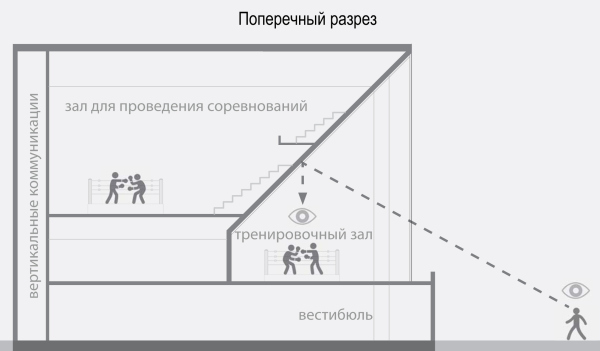 The Palace of Martial Arts in Luzhniki, the competition-winning project 2019Copyright: © UNK project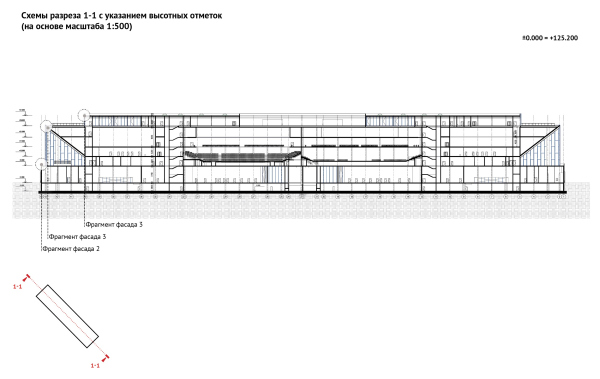 Longitudinal section view. The Palace of Martial Arts in Luzhniki, the competition-winning project 2019Copyright: © UNK project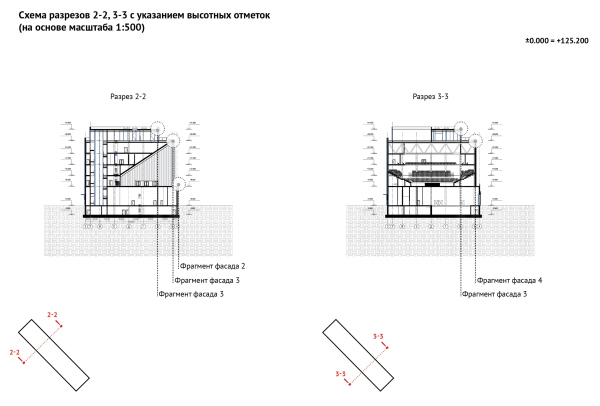 Cross-wise section views. The Palace of Martial Arts in Luzhniki, the competition-winning project 2019Copyright: © UNK project“We came up with the idea how to suspend the ceiling at a 45-degree angle so that the people walking down the Luzhniki Street can see what’s going on the halls. Furthermore, they have access to the best vantage point – from up above, meaning, this is how it reflects in the mirror. At first, this idea seemed a little bit like crazy but we checked it several times on our 3ds Max models, and everything worked just fine. Actually, this is not the first time such technique is used – SPEECH, for example, did a similar slanting mirror wall in the EXPO pavilion in Milan. In our project, however, we created an even more rigid geometry. This undercut destroyed the hegemony of the parallelepiped, making it look as if it were hovering above the ground, and endowing it with the reminiscences of the architecture of the Luzhniki Stadium itself. I am referring to the space under the stalls that was there in the Minor Sports arena and in the open air swimming pool. We took this trademark technique and interpreted it in our own way”. Thus, on the outside the optical effect transfers the accent to the refraction, almost like in a photo camera. The transparent walls reveal the inverted mirror prism, and the volume stops being a “crate”, taking on an aspect of some modernist experiment on fighting gravity: we see a glittering pyramid-shaped nugget, inverted with its wide side up to the top, yet testing on metallic columns, just as glittering – like some kind of a grotesque cornice or some peculiar tool for making physical experiments in the field of light refraction. The Palace of Martial Arts in Luzhniki, the competition-winning project 2019Copyright: © UNK projectThis reflection, ensured by the mirror surface of the polished metal, plays the meaning-forming role, turning the whole building into an iconic shape, similar to the wave-shaped roof of the nearby Irina Viner Gymnastics Center, whose land site, by the way, has similar specifics. The buildings occupy symmetric positions in respect to the central axis of Luzhniki, which runs through the Major Sports Arena, and take on a role of propylaea. However, while the Gymnastics Center is ostentatiously modern in respect to the architectural ensemble of Luzhniki, in the Center of Martial Arts we, first of all, as was already said, we can see an enlarged version of a cornice with columns, and second, thanks to the functional division into two organizations, a classical symmetric composition has been formed here. Just as the palace of Irina Viner, the Palace of Martial Arts is contemporary, yet it echoes the historical structures of Luzhniki. Yuliy Borisov is quite familiar with the historically formed “design code” of Luzhniki: as is known, he is also doing the reconstruction project for the Palace of Water Sports nearby – the project also won in the competition organized by the Moskomarkhitektury, and now it is all but completed. Making a reference to it in his new project was something that the architect considered a must. For example, on the façades, the zones that are partially closed – these are the zones of swimming pools in the middle, the management offices, and the hotel rooms for the athletes overlooking the Third Transport Ring – got vertical sunscreen lamellas of fiber concrete. Together with the cladding of the first floor, they remind about the light-weight concrete whose tiles cover all of the historical buildings of Luzhniki. Still another type of lamellas – from polished stainless steel on top of structural glazing – also quite “Soviet” style – is reminiscent of the Mayakovskaya metro station. “Formally, there are no monuments of architecture and heritage sites in Luzhniki, but it is my belief that it is a fully fledged town planning monument – Yuliy Borisov says – We realized that this project had to live with Luzhniki, supporting the ensemble character of the complex and its design code with its classic proportions, colonnades and characteristic materials such as LWC (light-weight concrete), and bas reliefs. And, second, and even more importantly, you’ve got an incredible piece of green land just a few kilometers away from the Kremlin, overlooking the Sparrow Hills. This is quite a rare sight to see in most localities around the world – well, they’ve got something like this in Tokyo but on a smaller scale. These two things – subjugation to the ensemble and openness to the city – we wanted to implement in our project”. |
|
